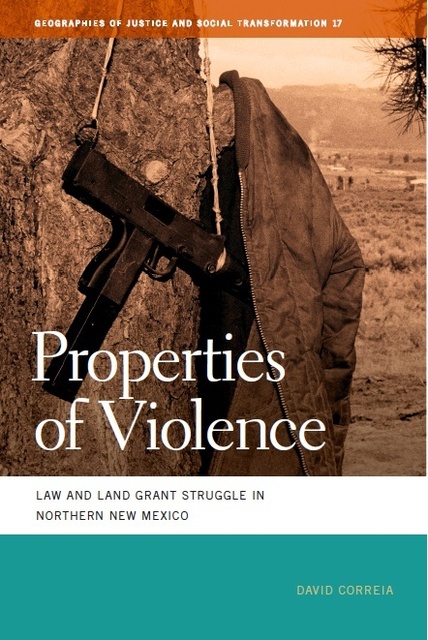What do the Black Hand, Dead Hands and the Ku Klux Klan have in common? The Tierra Amarilla Land Grant. In David Correia’s intensively researched history, Properties of Violence: Law and Land Grant Struggle in Northern New Mexico, property law itself is the worst villain among speculators, corrupt officials and gun-toting revolutionaries. A clash of cultures lensed through legal structures, it provides insight into the land grant struggle within the theme of legal dispossession. Favored highlights for you to flesh out in this excellent book: After revolts in 1680, the Spanish restrained settlers from encroaching on the Ute Indians, prohibiting settlement north of Abiquiú. Competing efforts for a land grant were continually made across generations of unsanctioned settlement, La Corporación de Abiquiú vs. Manuel Martinez, a prominent citizen. Finally successful after the war for Mexican independence, a compromise was adopted with homesteads and lands for common use and administered by Martinez and his heirs. Mexico establishes the Tierra Amarilla Land Grant in 1832, ignoring the Utes.In 1847 the US replaces Mexico, promising to honor land grants, but exploitation arrived in a witches brew of Jeffersonian Yeomantry, the Homestead Act of 1862 and resource-extracting capitalism. Jefferson wanted democracy built upon small landowners; the act limited plots to 160 acres. This had the undesirable effect of making Mexican land grants coveted because thousands of acres could be had in one piece. The Santa Fe Ring, a cabal of Americans that laid the groundwork for adjudication of common lands into private, develops, establishing a structure that favored the wealthy. After the Civil War, carpetbaggers arrived, personified in Thomas Burns and Thomas Catron. Through devious measures, large areas of common property were titled private. Burns used the time-tested method of lending money in the form of credit at his stores, where tobacco and whiskey were popular, and he took payments in the form of land. Catron hired Spanish-speaking attorneys and bribed clerks, judges and surveyors.In 1919 night riders cut fences and burned barns, which was blamed on “The Black Hand” and later on the Ku Klux Klan. Many dispossessed sheep herders worked seasonally in other states where they were victims of the Klan, and they adopted some Klan tactics. Indicative of the desperation of former grant residents, these tactics were largely ineffective. In 1937 Medardo Abeyta reconstitutes La Corporación, arguing that the “Dead Hands” of Mexico had prescribed common use in the Treaty of Guadalupe Hidalgo, but jurists recognized Martinez’ rights to sell common lands. Abeyta then attempted “possession by performance.” When a land grant member fenced an absent rancher off land, arguing common use, it was defeated due to titling. Attempts to elect a board for the grant was legally subdued by ranchers, who won an injunction.In 1951 Bill Mundy purchases a ranch alongside a member of La Corporación, Jose Maria Martinez. Mundy fences Martinez’ cattle off a pasture and La Corporacion sues, using hijuelas as a legal basis. Hijuelas, or personal wills describing a homestead, included rights to common lands use. Martinez argued that land sales had been misunderstood to include common land with the sales of homesteads and rejected in favor of Mundy. Violence erupted, and Mundy’s home was burned. A final case removed ownership of residents’ homesteads completely in former grants. This explosive development coincided with the arrival of the turbulent ’60s and a dynamic new leader.In 1958 a mesmerizing Pentecostal preacher, Reies Lopez Tijerina, forms Alianza, confronting the leadership of Al Sanchez, the Santa Fe District Attorney, and the hired council for La Corporación. A struggle developed: Tijerina encouraged disobedience, and Sanchez focused police pressure on Alianza. Tijerina staged a series of confrontations, and in May of 1967, Sanchez used an unrelated FBI memo as an excuse to investigate Tijerina. Threatened by Tijerina’s brother, Sanchez arrested Alianza’s leaders. Tijerina raided the courthouse to free them. When his supporters shot and wounded two officials, the National Guard was mobilized, and Tijerina was arrested. Propelled into the national eye, he defended himself and was acquitted. Targeted by bombings, a former policeman was discovered placing a bomb when it detonated prematurely, severing his hand. Tijerina earned the ire of COINTELPRO, a program to spy on groups that Hoover’s FBI considered subversive. Race was a factor in subversion, and non-whites were considered a particular threat and likely communists. Hoover’s ilk checked under the bed each night for Commies. Tijerina was eventually jailed on federal charges, and Alianza faded.The struggle continues against large landowners, developers and, ironically, the neighboring Apache tribe. In this wonderful clarification, Correia illustrates the legal decisions that precipitated these conflicts and the dispossession of poor residents in favor of well-connected ones. Property law, like the idea of property itself, is an illusion and a construct that serves political and social objectives.
Properties of Violence: Law and Land Grant Struggle in Northern New MexicoDavid CorreiaThe University of Georgia Presspaperback$24.95



